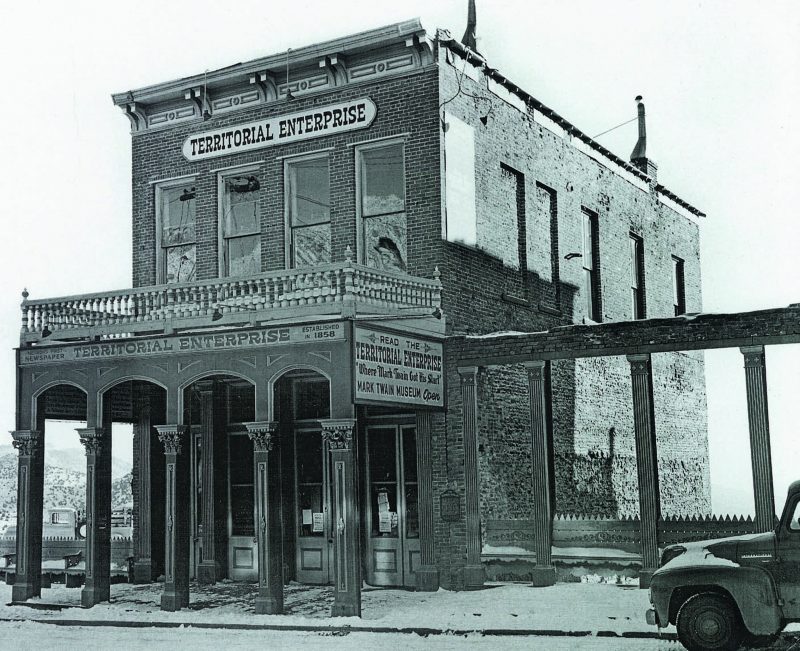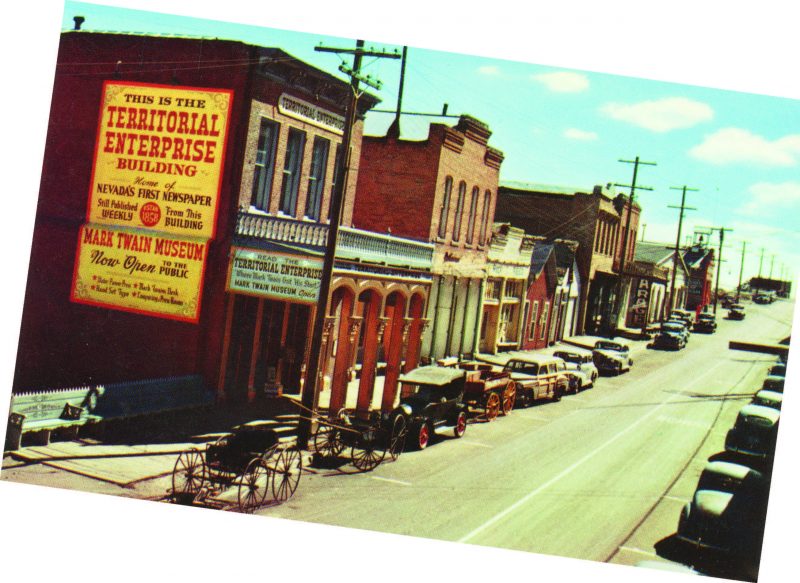The Territorial Enterprise
May – June 2016
The Territorial Enterprise
FIRST SHUTTERED 100 YEARS AGO, THE ICONIC COMSTOCK NEWSPAPER LIVES ON.
BY CHIC DIFRANCIA
When William Jernegan and Alfred James pulled the first sheet of the Territorial Enterprise off an old Washington hand press in Genoa on Dec. 18, 1858, a newspaper legend was born that has endured to this day. Future editor Lucius Beebe wrote in his 1954 book “Comstock Commotion: The Story of the Territorial Enterprise” that what would become one of the mightiest voices in Nevada journalism had a raucous beginning.
“Thus, in a mist both blasphemous and alcoholic, prophetic of things to come, was born the paper that was shortly to be the pattern and glass of frontier journalism everywhere, and eventually was to achieve immortality as one of the romantic properties of the Old American West,” Beebe writes.
He describes Jernegan and James as “seedy itinerants,” but the impact of their creation is still felt today. After its initial stints in Genoa and Carson City, the paper finally moved to Virginia City in 1860.
WIELDING A MIGHTY PEN
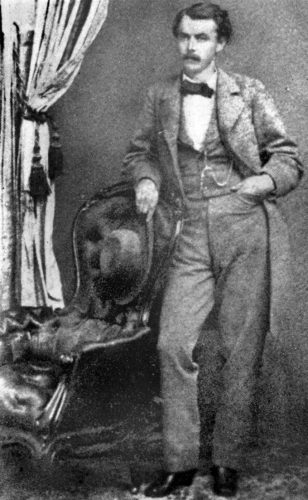
In 1861, Joseph Goodman and Denis McCarthy—both in their 20s and accomplished journalists—acquired the paper, and the were responsible for hiring such legendary writers as William Wright (Dan DeQuille), Samuel Clemens (Mark Twain), and Rollin Daggett, who went on to become a U.S. Representative for Nevada. Much has been written about the literary output of DeQuille and Twain over the years, but it’s interesting to note DeQuille stayed with the Enterprise for 31 years, while Twain was employed there a mere 22 months. Goodman was editor and owner until 1874 and during his tenure the Enterprise became the liveliest sheet on the Comstock.
In the early 1870s, when the mines were in bonanza, powerful mining interests were wrestling for control of The Comstock. William Sharon of the Bank of California represented one of those interests, and he was running for the U.S. Senate. Goodman—now sole owner of the Enterprise and a devout enemy of Sharon—destroyed the man with a blistering salvo delivered in his editorial columns. Sharon lost the election in 1872, but on his next try in 1874, he did what a man of unlimited wealth would do; he purchased the Enterprise for $50,000 and used it for his political ambitions. Sharon won his coveted senatorial seat in the election of 1874. Such was the influence of the most powerful newspaper in Nevada.
THE INK RUNS DRY
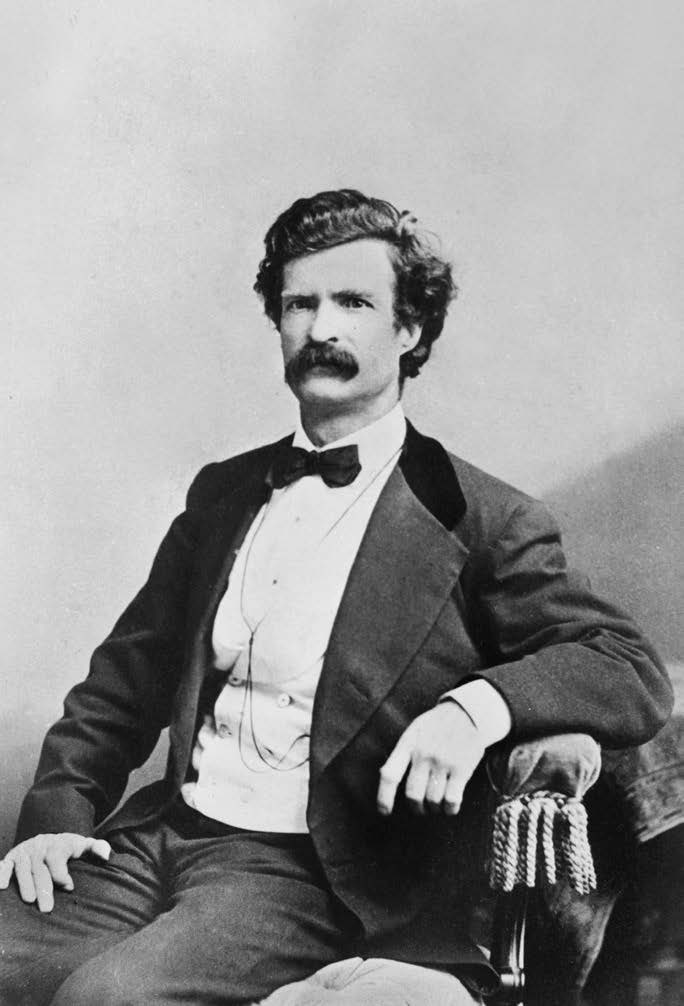
The great fire of 1875 destroyed the Territorial Enterprise, which printed from the Gold Hill Daily News until it was rebuilt in 1876. A number of editors and owners came and went, as the mines continued their sway over the fortunes of the town.
The paper suspended operations for 11 months in 1893 with a simple note: “For sufficient reasons we stop.” It was revived in December of 1893 under new ownership, and in 1896, it changed hands for the last time when Frank Blake took charge of the paper. Blake started at the paper when he was just 16 years old, working in almost every capacity before taking over as editor. By 1900, the Comstock was in rapid decline. The mines had played out a decade earlier, and Virginia City came upon hard times, taking the Enterprise along with it. Blake stayed at the helm until the Enterprise gasped its last breath, and went under for the final time on May 30, 1916, when it was taken over by its long-time rival: the Virginia Evening Chronicle. Under the Chronicle, the Enterprise never saw the light of day and when the Chronicle suspended in August of 1927, the names of both newspapers were abandoned to history.
A DYNAMIC DUO
 Lucius Beebe & Charles Clegg met in Washington D.C. the early 1940s in at the home of Evalyn Walsh McLean, owner of the Hope Diamond. Beebe and Clegg formed a partnership and had a personal relationship until Beebe’s death in 1966 at age 63. Beebe had been a journalist for the New York Herald and wrote a column about Manhattan high life called “This New York.” He is credited with coining the term “Cafe Society.” He authored more than 30 books in his lifetime, many on railroading, on which he was an aficionado. Clegg was a contributor to many of Beebe’s books. In 1954, Beebe published “Comstock Commotion”—a book about the history of the Territorial Enterprise.
Lucius Beebe & Charles Clegg met in Washington D.C. the early 1940s in at the home of Evalyn Walsh McLean, owner of the Hope Diamond. Beebe and Clegg formed a partnership and had a personal relationship until Beebe’s death in 1966 at age 63. Beebe had been a journalist for the New York Herald and wrote a column about Manhattan high life called “This New York.” He is credited with coining the term “Cafe Society.” He authored more than 30 books in his lifetime, many on railroading, on which he was an aficionado. Clegg was a contributor to many of Beebe’s books. In 1954, Beebe published “Comstock Commotion”—a book about the history of the Territorial Enterprise.
TERRITORIAL ENTERPRISE
FACTS
- First newspaper printed in Nevada Dec. 18, 1858 in Genoa
- First Nevada newspaper printed by steam August 1863 in Virginia City
- First Nevada newspaper printed by linotype December 1895 in Virginia City
Notable staff:
Joseph Goodman
Dan DeQuille
Mark Twain
Rollin Daggett
Alfred Doten
Wells Drury
(Lyin’) Jim Townsend
Fred Hart
Lucius Beebe
Bob Richards
ANOTHER CHANCE AT HISTORY
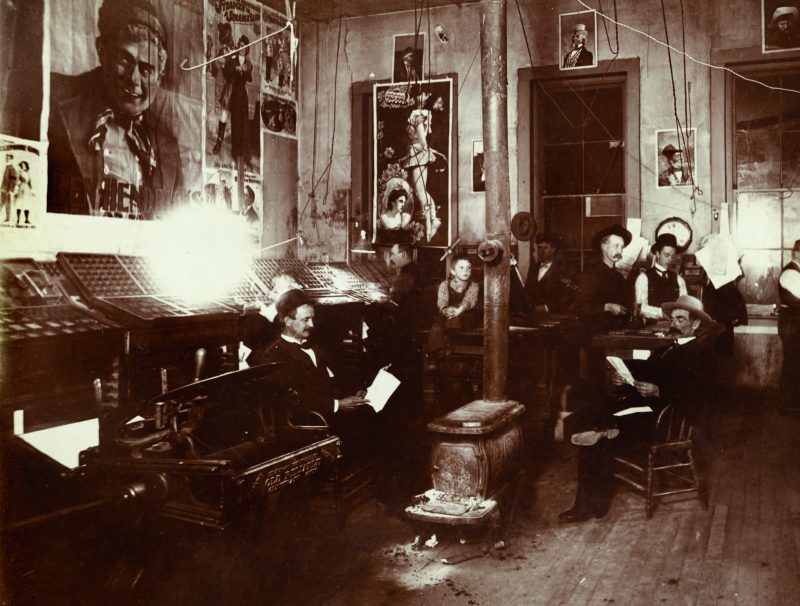
In 1930, Vincent Nevin—former editor of Virginia City’s Monday Budget— purchased the old printing plant of the Chronicle and began publishing the Virginia City News. In doing so he legally acquired the now-abandoned names of the Territorial Enterprise and Virginia Evening Chronicle. Thus was born conjoined newspaper triplets that have never been separated.
Nevin sold the Virginia City News in 1943 and the paper changed hands a half dozen times. In 1951, Lucius Beebe and Charles Clegg—newly moved from New York—bought the Virginia City News for $5,500. Beebe had done his homework and knew about the iconic sleeping giant that lay hidden in the dusty archives of the Virginia City News. On May 2, 1952, after a 36-year slumber, the new Territorial Enterprise made its debut on the Comstock.
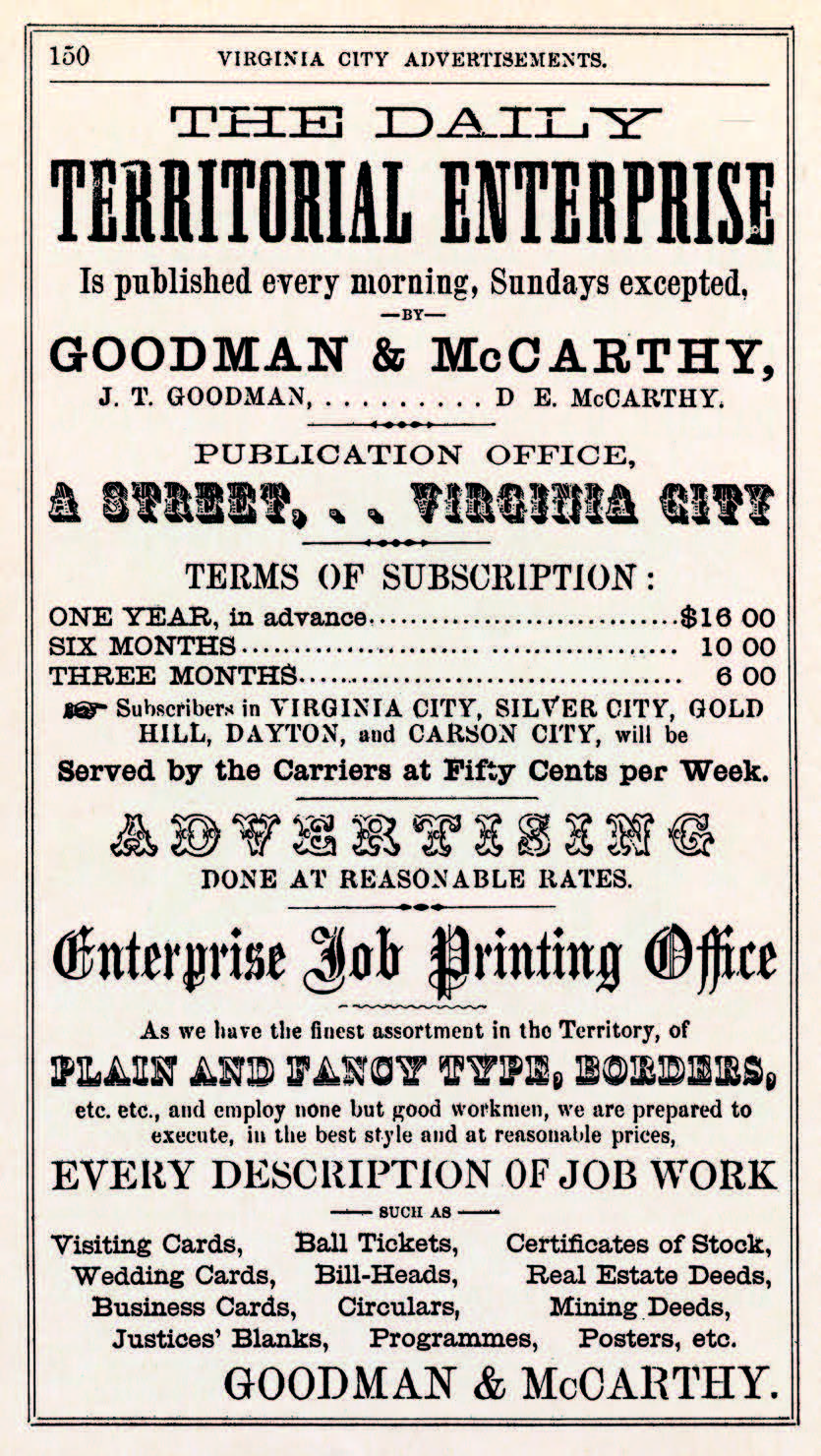 Tabloid in size and printed by letterpress, the new Enterprise was a remarkable newspaper from the start. Clegg—a writer and photographer—had purchased antique ornate typefaces that gave the paper a stunning look. The newspaper now carried dual names with Territorial Enterprise on top in large letters and Virginia City News with smaller type beneath it. Within two years the Enterprise became the largest weekly west of the Mississippi, and eventually had readers in all 50 states and 16 foreign countries
Tabloid in size and printed by letterpress, the new Enterprise was a remarkable newspaper from the start. Clegg—a writer and photographer—had purchased antique ornate typefaces that gave the paper a stunning look. The newspaper now carried dual names with Territorial Enterprise on top in large letters and Virginia City News with smaller type beneath it. Within two years the Enterprise became the largest weekly west of the Mississippi, and eventually had readers in all 50 states and 16 foreign countries
By 1960 the creative juices at the Enterprise were starting to wane and Beebe sold the Enterprise to local businessman Roy Shetler. Having little newspaper publish- ing experience, Shetler sold the Enterprise a year later to a New York syndicate headed-up by Jack Tell. After Tell, the Enterprise changed ownership several times until 1968, when Virginia City businesswoman Dee Schafer purchased it. Under Schafer the Enterprise lay dormant until 1980 when she began publishing it once again with her son, John.
A HOME IN THE FUTURE
In the June 1985 edition of the paper, the Schafer family announced the Enterprise was being sold to Thomas Muzzio and his Nevada corporation—Josh Inc. In addition to printing the newspaper, Muzzio also started publishing a quarterly Territorial Enterprise magazine in the Spring of 1986. Because of high printing cost and writers fees, the Enterprise magazine was discontinued after the first issue. Muzzio continued publishing the print version of the paper, but eventually shut it down and took it to the Internet in 1996, where he established a website dedicated to the historic journal.
The last effort to revive the print version of the paper took place in early 2000, when Muzzio signed an agreement with Lloyd Pendergraft and Nick Nicosia to publish a weekly edition of the paper and companion website. In May 2000, the new 28-page Enterprise hit the streets. Unfortunately, like so many small newspapers financially struggling to stay afloat, the new Enterprise was forced to suspend operations after its first edition.
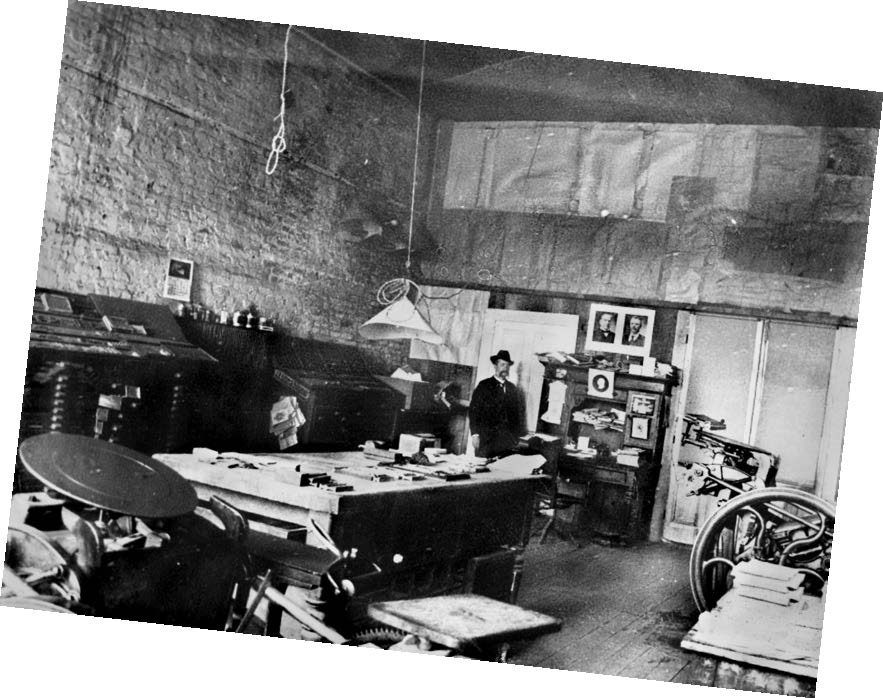 In February 2015, a news release came out of Jefferson City, Mo., that new owners were to revive the Enterprise in the form of a website and a glossy monthly magazine. After several issues, this Enterprise ceased operations when ownership and trademark of the famed journal came into question. Muzzio—the legal owner—is in the process of revamping his T.E. Foundation website and plans to launch social media sites—including Facebook—for the Enterprise.
In February 2015, a news release came out of Jefferson City, Mo., that new owners were to revive the Enterprise in the form of a website and a glossy monthly magazine. After several issues, this Enterprise ceased operations when ownership and trademark of the famed journal came into question. Muzzio—the legal owner—is in the process of revamping his T.E. Foundation website and plans to launch social media sites—including Facebook—for the Enterprise.
Whether we will ever see a print version of the Territorial Enterprise again is unknown, but it’s comforting to know that this iconic Comstock newspaper is still alive as it enters into the digital age.
WORTH A VISIT
territorial-enterprise.com
Mark Twain Museum
53 South C St.
Virginia City, NV 89440
visitvirginiacitynv.com, 775-847-0525

